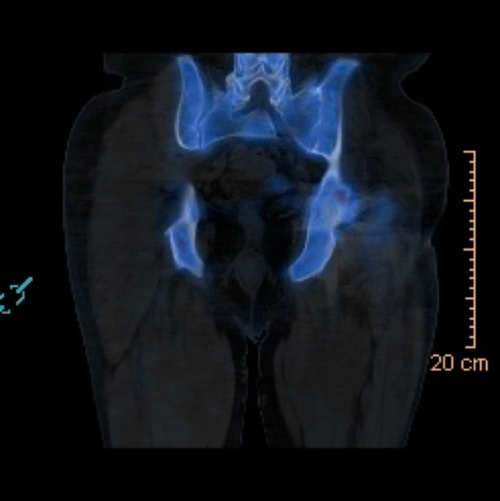CASE 39: Revision of a loose stem using a modular taper fluted stem
The Story
“This 76-year old gentleman presented with indolent left hip pain worsening over 2-years.
He had a background of trauma to the left hip resulting in fracture requiring a left total hip replacement. This was a hybrid hip replacement (uncemented stem with a cemented socket). He made a good recovery from this procedure.
One year later he experienced pain from the left hip, requiring ibuprofen to control.
He presented to his local hospital one year later. At the time of presentation, some investigations demonstrated;
ESR of 27mm/H which was not abnormal for this patient
Radiograph demonstrating 10mm of stem subsidence between 1-year post-op and the time of presentation (roughly a year)
Culture negative hip aspiration
MRI spine demonstrating L2 stenosis
A year on, he was referred to our service.”
The Investigation
On examination he had an antalgic short leg gait and was Trendelenburg test positive on the left side. He used a walking stick for mobilising. He only had 40% lumbar spine motion. Range of movement in the left hip was reduced due to pain. Sensation was reduced in all dermatomes of the left leg.
His pre-operative Oxford hip score was 18/48.
Investigations at this time demonstrated;
CRP of 3.6mg/L and an ESR of 19mm/H helping to rule out infection
CT SPECT demonstrating high uptake around the neck and tip of the implanted stem
The Evidence
This CT SPECT scan shows increased uptake of the tracer around the lesser trochanter and the tip of the femoral stem, a common radiological manifestation of aseptic loosening.
This bone scintigraphy scan demonstrates increased uptake of trace in the same areas as the SPECT CT adding to the suspicion of aseptic loosening.
The Diagnosis
The diagnosis was a loose left femoral stem requiring revision.
The Operation
This patient required revision of the left femoral component only. The acetabular component remained well fixed from the first procedure.
Intraoperatively;
Posterior approach
4 stay sutures placed
Stem found to be loose, socket was well fixed
Stem removed
MP link stem 14 x 210mm with XXL body and medium 36mm ceramic head implanted
This achieved stability and a good length
Closure with vicryl, monocryl and glue
The Outcome
This series of radiographs demonstrates the position of the stem post-operatively with the retained acetabular component.
The Verdict
“CT spect shows which components are loose, allowing retention of well fixed components if well positioned and no infection present.
Revision surgery in octogenarians should not be refused due to age.
This surgery had an excellent patient outcome. One year post surgery, at the age of 88 years old, the patient needed no support for walking distances of more than one mile.




















